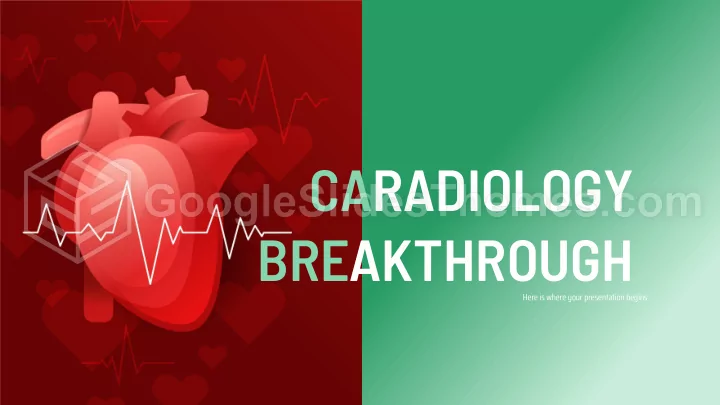

CARADIOLOGY BREAKTHROUGH Here is where your presentation begins
01 02 OBJECTIVES METHODOLOGY Here you could describe the topic Here you could describe the of the section topic of the section 03 04 RESULTS ANALYSIS CONCLUSIONS Here you could describe the Here you could describe the topic of the section topic of the section
INTRODUCTION INTRODUCTION Mercury is the closest planet to the Sun and the smallest one in the Solar System —it’s only a bit larger than our Moon. The planet’s name has nothing to do with the liquid metal since it was named after the Roman messenger god, Mercury
MARS SATURN Saturn is composed mostly of hydrogen and Despite being red, Mars is a cold place, not hot. helium It’s full of iron oxide dust JUPITER VENUS Jupiter is a gas giant and the biggest planet in Venus has a beautiful name, but it’s terribly hot, our Solar System even hotter than Mercury
GOALS MERCURY VENUS MARS Mercury is the closest planet to the Sun and the Venus has a beautiful name and is the second Despite being red, Mars is a cold place, not hot. smallest one in the Solar System —it’s only a bit planet from the Sun. It’s terribly hot and its It’s full of iron oxide dust, which gives the planet larger than our Moon atmosphere is poisonous its reddish cast
METHODS MERCURY JUPITER It’s the biggest planet Mercury is the closest planet to the Sun in our Solar System SATURN VENUS Venus has a beautiful It’s composed mostly of hydrogen and helium name, but it’s terribly hot
CLINICAL TRIAL PRECLINICAL PHASE 1 PHASE 2 PHASE 3 Lab Studies Human Safety Expanded Safety Efficacy & Safety
RESEARCH AND PUBLICATIONS “the second planet from the Sun. It’s terribly the Sun and the smallest one in the Solar mostly of hydrogen and helium. It’s over 95 hot and its atmosphere is extremely System —it’s only a bit larger than our Moon” times more massive than the Earth” poisonous” by VENUS by MERCURY by SATURN
REFERENCE Here you can list your reference websites ● Here you can list your reference websites ● Here you can list your reference websites ● Here you can list your reference websites ● Here you can list your reference websites ● Here you can list your reference websites ● Here you can list your reference websites ●
FACTORS TO CONSIDER Venus has a beautiful name, but Mercury is the closest planet It’s a gas giant and the it’s terribly hot to the Sun biggest planet VENUS MERCURY JUPITER
TRIAL TIMELINE EXPERIMENTA TION RESEARCH STEP 2 STEP 1 Venus has a beautiful name, but it’s Mercury is the closest planet to the terribly hot Sun CONCLUSIONS PRECLINICAL STEP 5 STEP 3 Neptune is the fourth-largest planet in Despite being red, Mars is a cold place, our Solar System not hot RESULTS STEP 4 The Sun is the star at the center of the Solar System
METHODOLOGY 6 MONTHS People with common Experimentation habits time 5% Confirmation rate SAMPLE GOAL 20 - 80 Study the connection participants between habits and the disease RESULTS POSSIBLE CAUSES Venus has a beautiful name and is the Venus has a beautiful name and is the second planet from the Sun. It’s terribly second planet from the Sun. It’s terribly hot — even hotter than Mercury — and its hot — even hotter than Mercury — and its atmosphere is extremely poisonous atmosphere is extremely poisonous
TENDENCY Mercury is the closest planet to the Sun and the smallest one in the Solar System —it’s only a bit larger than our Moon. The planet’s name has nothing to do with the liquid metal since it was named after the Roman messenger god, Mercury IF YOU WANT TO MODIFY THESE GRAPHS, CLICK ON THEM, FOLLOW THE LINK, CHANGE THE DATA AND REPLACE THEM
RESULTS EXPERIMENT A EXPERIMENT B OUTCOME OUTCOME TREATMENT Test 1 Test 2 Test 3 TREATMENT Test 1 Test 2 Test 3 Group 1 315 285 600 Group 1 315 285 600 Group 2 210 390 600 Group 2 210 390 600 Group 3 240 165 580 Group 3 240 165 580
RESULTS ANALYSIS NEPTUN SATURN E 6% 57% 13% 12% 23% 42% 64% 64% 64% 24%
45% 1-5% GENETIC CASES WHERE HERITABILITY GENETIC DIFFERENCES WERE IDENTIFIED
CONCLUSIONS Mercury is the closest planet to the Sun and the smallest one in the Solar System —it’s only a bit larger than our Moon. The planet’s name has nothing to do with the liquid metal since it was named after the Roman messenger god, Mercury
THANKS Design by https://www.fiverr.com/users/shaikhzainwork
Recommend
More recommend